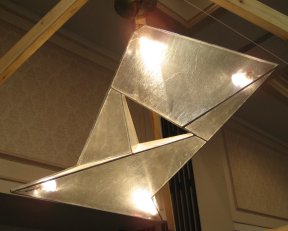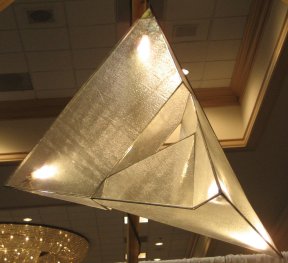For most people, the word “polyhedron” conjures up an image of a cube, a tetrahedron, or something similar—a solid figure with flat faces. If the polyhedron is regular, each face has the same size and shape.



But polyhedra come in all sorts of guises. The faces of a polyhedron can have different sizes and shapes, just as long as each one is a polygon. The polyhedron itself can have a hole (or two or more).
One particularly intriguing polyhedron was discovered in 1977 by Hungarian mathematician Lajos Szilassi. This polyhedron has seven faces, 14 vertexes, 21 edges, and a hole. Topologically, if it were smoothed out, it would be equivalent to a doughnut (or torus). You could describe as a toroidal heptahedron. Each face is a six-sided polygon.
Like the tetrahedron, the Szilassi polyhedron has the remarkable property that each of its faces touches all the other faces.
For anyone who would like to make a model of the Szilassi polyhedron, there are templates available at http://www.drking.plus.com/hexagons/szilassi/index.html or http://www.minortriad.com/szilassi.html.
The Szilassi polyhedron also provides insight into the problem of coloring maps. On a flat surface (or the surface of a sphere), a map must be colored with four colors so that no two adjacent regions are the same color. For a map on the surface of a torus, the number is seven. So, each face of the Szilassi polyhedron’s seven faces must be a different color to ensure that no two adjacent faces have the same color.
By replacing each face of the Szilassi polyhedron with a vertex and each vertex with a triangular face, you end up with another unusual polyhedron known as the Császár polyhedron. It’s the only known polyhedron, aside from the tetrahedron, that has no diagonals. It also has a hole, making it topologically equivalent to a torus. This polyhedron was discovered in 1949 by Ákos Császár.
Hans Schepker of Harrisville, N.H., has been crafting “mathematically correct” sculpture out of paper, glass, and other materials for many years. So, when he learned about the Szilassi polyhedron, he had to make one. In March, he presented his first glass model to Szilassi himself, who was attending the 7th Gathering for Gardner in Atlanta.
Schepker also installs lights inside his glass creations. A new version of the Szilassi polyhedron, featuring four lights, was the centerpiece of Schepker’s display at the Joint Mathematics Meetings, held earlier this month in New Orleans.
If you wish to comment on this article, see the MathTrek blog version. For more math fun, go to http://blog.sciencenews.org/mathtrek/.






